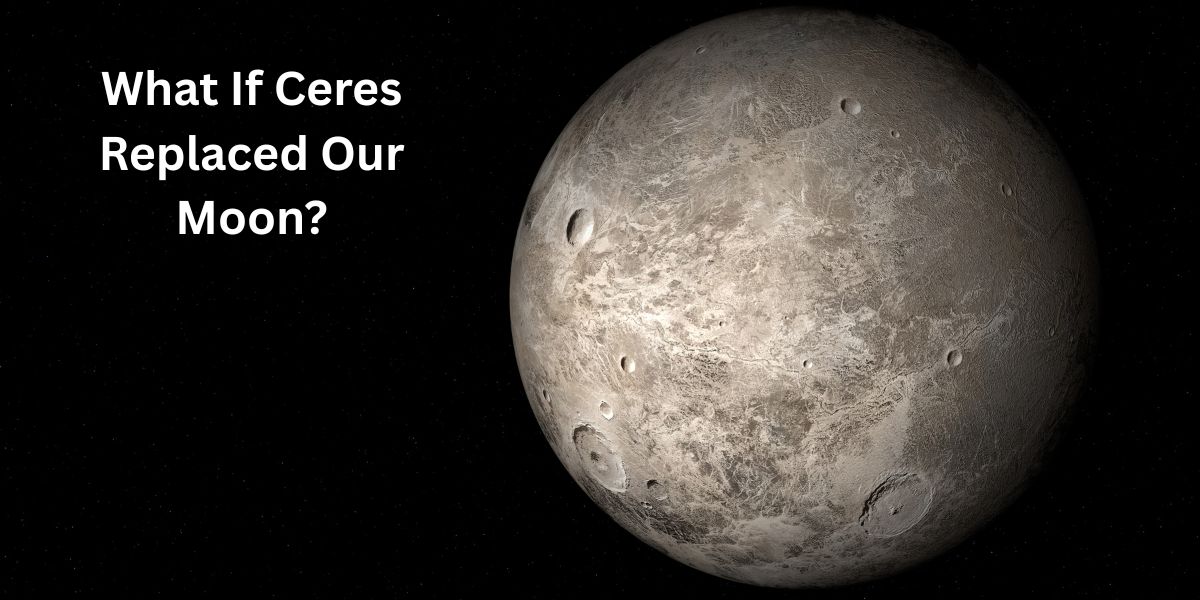Imagine looking up at the night sky and seeing a strange, round object instead of our familiar Moon. But this isn’t just any space rock—it’s Ceres, the largest object in the asteroid belt between Mars and Jupiter. What would happen if Ceres took the Moon’s place? Would nights be brighter? Would tides change?
Ceres is much bigger than most asteroids but smaller than our Moon. It’s like a tiny, rocky world with ice hiding beneath its surface. If it suddenly appeared where the Moon is, Earth would feel very different.
What would life be like if Ceres became our new Moon?
What Is Ceres?
Ceres is a dwarf planet—a small, round world that isn’t big enough to be a full planet. It sits in the asteroid belt, a ring of rocks between Mars and Jupiter.
- Size: Ceres is about 1/13th the size of Earth’s Moon.
- Surface: It has mountains, craters, and even icy volcanoes!
- Water: Scientists think Ceres has more fresh water than all of Earth’s rivers and lakes combined!
Even though Ceres is small, it’s special because it’s the only dwarf planet in our solar system’s inner part.
How Big Is Ceres Compared to the Moon?
Our Moon is 2,159 miles (3,474 km) wide, while Ceres is only 587 miles (945 km) wide. That means if Ceres replaced the Moon:
- It would look much smaller in the sky—about 1/4 the size of the Moon.
- It would reflect less sunlight, making nights darker.
- Its gravity is weaker, so tides on Earth would shrink.
Fun Fact: If you held a basketball (Moon) and a tennis ball (Ceres) at arm’s length, the tennis ball would look tiny next to the basketball!
Would Ceres Affect Earth’s Tides?
Yes, but not as much as the Moon does. The Moon’s gravity pulls on Earth’s oceans, creating high and low tides.
- Moon’s gravity: Strong enough to move whole oceans.
- Ceres’ gravity: Too weak—tides would be 3 times smaller.
- Result: Beaches would have very little wave movement, affecting sea life and coastal weather.
Without strong tides, some fish and plants might struggle to survive.
Would Nights Be Brighter or Darker?
Nights would be darker because:
- The Moon reflects 12% of sunlight (bright white glow).
- Ceres reflects only 9% of sunlight (dimmer, grayish look).
- Since Ceres is also smaller, it wouldn’t light up the sky as much.
Example: Imagine switching from a bright flashlight (Moon) to a small, dim nightlight (Ceres).
Could Ceres Support Life?
Ceres itself doesn’t have life, but it has ingredients for life:
- Water ice under its surface.
- Organic molecules (carbon-based chemicals).
- Possible underground salty ocean.
If Ceres were closer to Earth, scientists might study it for signs of tiny life forms. But as our Moon? It wouldn’t change life on Earth—just make nights darker!
Would Ceres Change Earth’s Orbit?
No, because Ceres is too small to affect Earth’s path around the Sun.
- The Moon is 1.2% of Earth’s mass.
- Ceres is 0.00015% of Earth’s mass—like comparing an ant to an elephant!
Earth would keep moving normally, just with weaker tides and darker nights.
Could Humans Live on Ceres?
Maybe one day, but not easily:
- Low gravity (3% of Earth’s)—people would float like astronauts.
- Very cold (-100°F / -73°C on average).
- No air to breathe.
Scientists might build bases there, but it wouldn’t be a cozy home like Earth.
Would Ceres Look Beautiful in the Sky?
Ceres wouldn’t look as stunning as the Moon, but it would still be interesting:
- Gray and speckled (covered in craters).
- No big dark spots (like the Moon’s “man in the Moon” marks).
- Smaller size—more like a bright star than a big glowing circle.
Some people might miss the Moon’s bright face, but space lovers would enjoy studying Ceres up close!
Conclusion
If Ceres replaced the Moon, Earth would have smaller tides, darker nights, and a tiny new neighbor in the sky. While it wouldn’t hurt our planet, we’d definitely notice the changes. The Moon is special—just the right size and distance to make Earth a perfect home.
📌 Frequently Asked Questions
Is Ceres bigger than the Moon?
No, Ceres is much smaller. The Moon is about 4 times wider than Ceres.
Does Ceres have water?
Yes! Ceres has more fresh water than Earth’s lakes and rivers, but it’s mostly frozen underground.
Could Ceres hit Earth?
No, Ceres is far away in the asteroid belt and doesn’t move toward Earth.
Why is Ceres called a dwarf planet?
Because it’s round like a planet but too small to clear its orbit of other asteroids.
Can we see Ceres from Earth?
Yes, but only with a telescope. It looks like a tiny, faint star.
What would happen if Ceres exploded?
Ceres is rocky and icy—it wouldn’t explode. But if it broke apart, the pieces would float in space.
Does Ceres have volcanoes?
Yes! They’re called cryovolcanoes—they shoot out icy slush instead of lava.
How far is Ceres from Earth?
Ceres is about 257 million miles (414 million km) away—much farther than the Moon.
Could Ceres ever become a moon?
Only if it got pulled into Earth’s orbit, which is very unlikely.
What color is Ceres?
Mostly gray with some brown and blue patches from minerals and ice.
